“It’s iconic.”
“How?”
“It just is.”
“But it’s only six miles long.”
“Aye. It’s still iconic.”
I didn’t believe it. I’d heard of the Carnethy 5, but I still couldn’t understand why it had such a reputation when it was short and when even the elevation per mile wasn’t that intimidating. But FRB’s Dad, a runner so good he has no more room for trophies in his house, had entered and so so did we. FRB comes from East Lothian, so we could combine the race – in MidLothian — with a family visit. Otherwise there were factors definitely against me agreeing to do it. It cost £17! That’s a road race price. And it would mean a nine-hour round trip to run a six mile race, something I would normally consider ludicrous. Then there was the small matter of Storm Dennis.
But I always like to visit Scotland, and I had run once with FRB and Dad FRB on the Pentland Hills, where the Carnethy 5 is based (it is named for Carnethy running club, which is in turn named for Carnethy, one of the Pentland hills). The race commemorates a 1302 battle that involved William Wallace. From Carnethy’s website:
In February 1302, a messenger arrived at Neidpath Tower to ask Sir Simon Fraser to meet someone at Biggar. Sir Simon Fraser rode hard, for the person he was to meet was none other than Scotland’s hero — Sir William Wallace. The Wallace’s plan was for himself to be seen gathering together an army up north, while Sir Simon waited with the main army in the south. Sure enough the plan worked, for when the English heard that The Wallace was getting ready to attack from the north, they left their winter quarters in Edinburgh heading south — Sir Simon waited.
Randolf the English General was unprepared for a fight. His army was separated into three groups of 10,000 each, some miles apart. At Dryden they suddenly found themselves confronted by 8,500 Scots. Colmyn, Saintclair and Fraser, loyal friends of Wallace soon carried the day, and rushed on to Rosewell to meet the 2nd army. The weary Scots were again triumphant, but tired, and when yet another 10,000 men approached they were ready to flee. But Sir Simon was a crafty gent, he had been warned about the 3rd army, and had sent a few ot his men to carry two tree trunks up a neighbouring hill. Then Sir Simon shouted to his men… Well, part of the old ballad says it better:
“Look ower, look ower, on yonder hill,”
Quo’ Sir Simon lood and clear,
They blich’t and saw the lift gao ill,
Then saw a cross appear.
“Tis gude St. Andrew” cried ae man,
Then doon they gaed to pray,
“Gae to,” they heard the gude Sir Simon,
“Gae to,” we’ll win the day.”The inspired Scots rushed into battle!
This would be the 50th running of the race, so I knew that if they could go ahead, they would. But fell races and hill races were being cancelled, and we checked the forecast regularly in the week before, and it never got any better. Depending on which metereologists I checked (I’m fond of the Norwegians YR.no weather forecast), the winds were going to be between 40 and 75 miles an hour, and that stayed true until the Friday, when we set off. It didn’t matter that Storm Dennis was going to wreak more havoc in England than Scotland: we were going. I was sure the race would be called off. I know it had been run the year before even though runners had been told at the start that marshals and Mountain Rescue would be lying down because they wouldn’t be able to stand, the wind was so strong. Even so, I was sure that no race organizer would allow marshals to stand out for a few hours in 70mph winds.
Carnethy said they would make a decision at 11am on the Saturday. If we didn’t hear owt, the race would go ahead. The race starts at 2pm, and part of the reason for the cost is that runners get bussed to the start from race HQ at Beeslack High School in Penicuik. We had to set off at 11am to get to the school in good time, and the only clue as to Carnethy’s decision was a retweet from someone wishing everyone doing Carnethy 5 good luck. Even so, I didn’t believe it was on until we got to Penicuik and the car park was full and there were many lean people wandering about in waterproofs and lycra tights. I had been advised to bring “EVERYTHING” and so I had: although I run in shorts even in snow – my legs rarely get cold – I had brought long tights and plenty of layers. The race organizers required everyone to carry full body cover, and a long-sleeved top. In practice, most people in the hall seemed to be wearing all their kit at once, including me.
I was more nervous than usual. I’d had a race stress dream the night before (the one where you can’t find your kit or shoes or something), and I’d convinced myself that everyone in Scotland was a fabulous hill runner, and that they were all Jasmin Paris (who runs for Carnethy) and Finlay Wild (who always wins the Ben Nevis race), and that I would be the lumbering Englishwoman – actually half Welsh but that’s irrelevant – at the back. Tim, a friend of FRB’s who he had met a few years ago at Trapain Law race, but whose wife is from up here, reassured me. The race field is no different to what you are used to, he said. All sorts. You won’t be last.
My club-mate Dom was also running the race, as he was combining it with a visit to Edinburgh. It’s not often that we remember to get team photos but here is one:
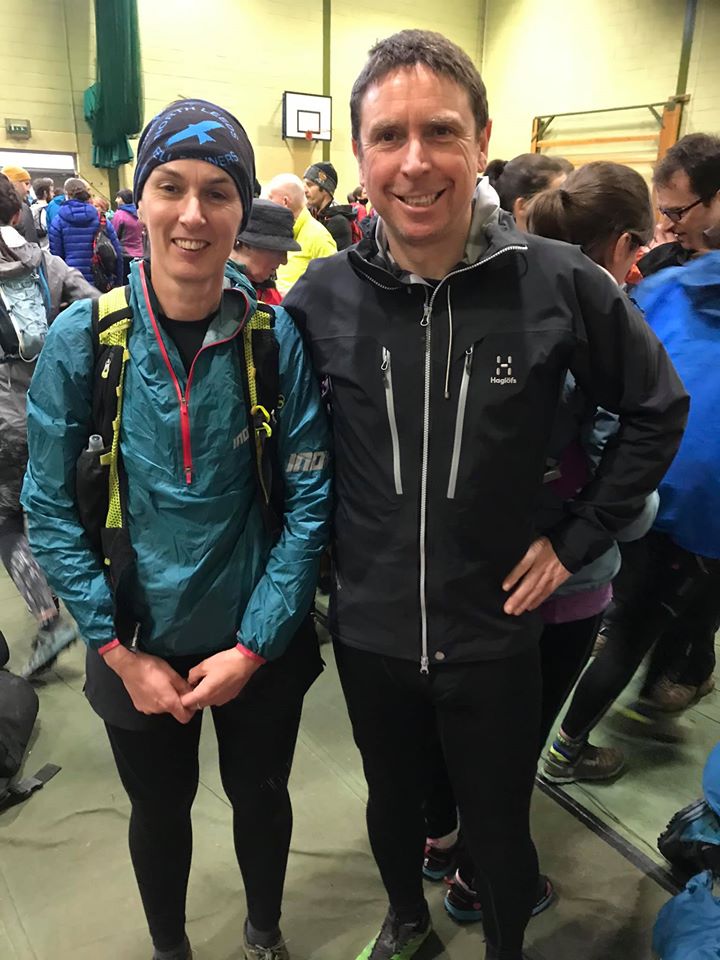
I think I made five toilet visits, only four of which were necessary, and eventually, we made our way out to wait for a bus to be driven ten minutes to the start. The kit check was carried out in the bus queue, and consisted of, “have you got a map? Gloves? Hat? OK then.”
The bus took us to a field underneath Carnethy Hill, where a few marquees were managing to stay upright. The winds weren’t too bad down here, and my nerves were slightly soothed by the piper standing on a mound nearby, piping us up five snow-capped hills.
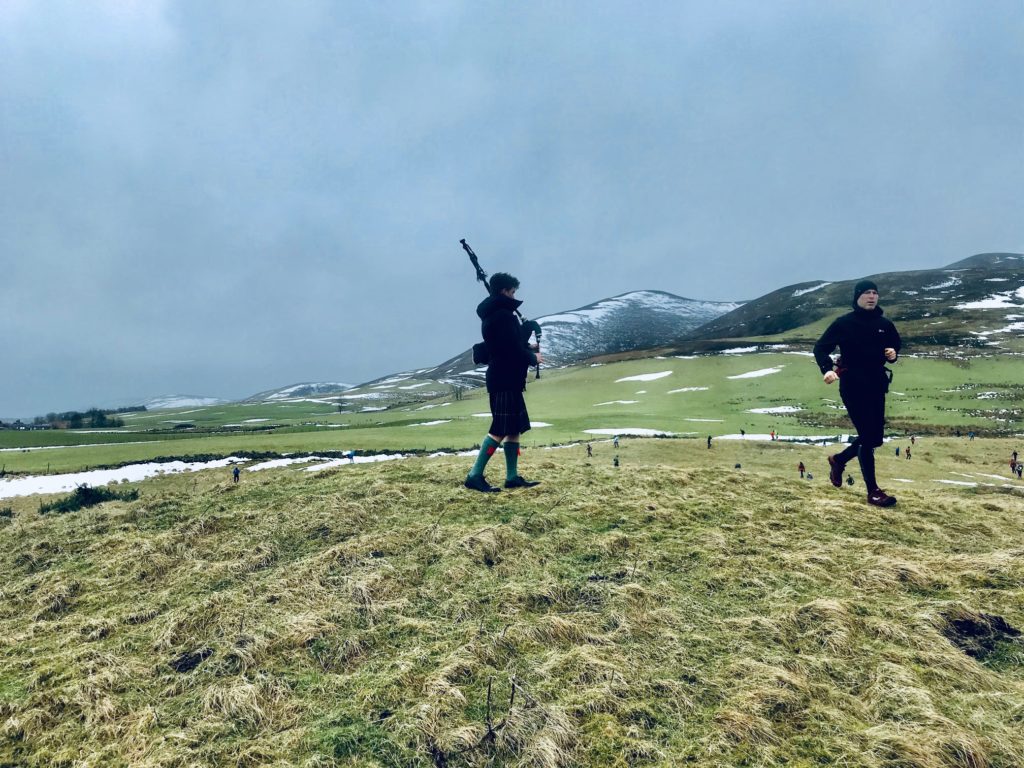
We’d got one of the last buses so didn’t have long to wait for the start. I managed to warm up, but still decided to keep my jacket on. I was kitted out excessively according to my usual standards: long tights, which I’ve only ever worn for Rombald’s in snow and cold, and a waterproof jacket.
There were announcements but most were carried away by the wind. I expect they were the usual: don’t do anything stupid and if you fall over find a marshal and report back to the marquees. And then we were off. FRB, who has run Carnethy before, had given me some tips: there was a long stretch of very boggy and wet ground before we began to rise up to climb Scald Law. Stay to the left, he said. It will still be boggy but better. Also, head for the tiny hi-viz dot standing by some green bushes, which is a marshal. I squinted, saw a tiny hi-viz dot, just about, and agreed to do that. There was a gunshot, or cannon, or something, and we set off. Steady away, Rose, you will need your strength for the wind. Even so I was anxious: don’t be last, don’t be last.
So silly.
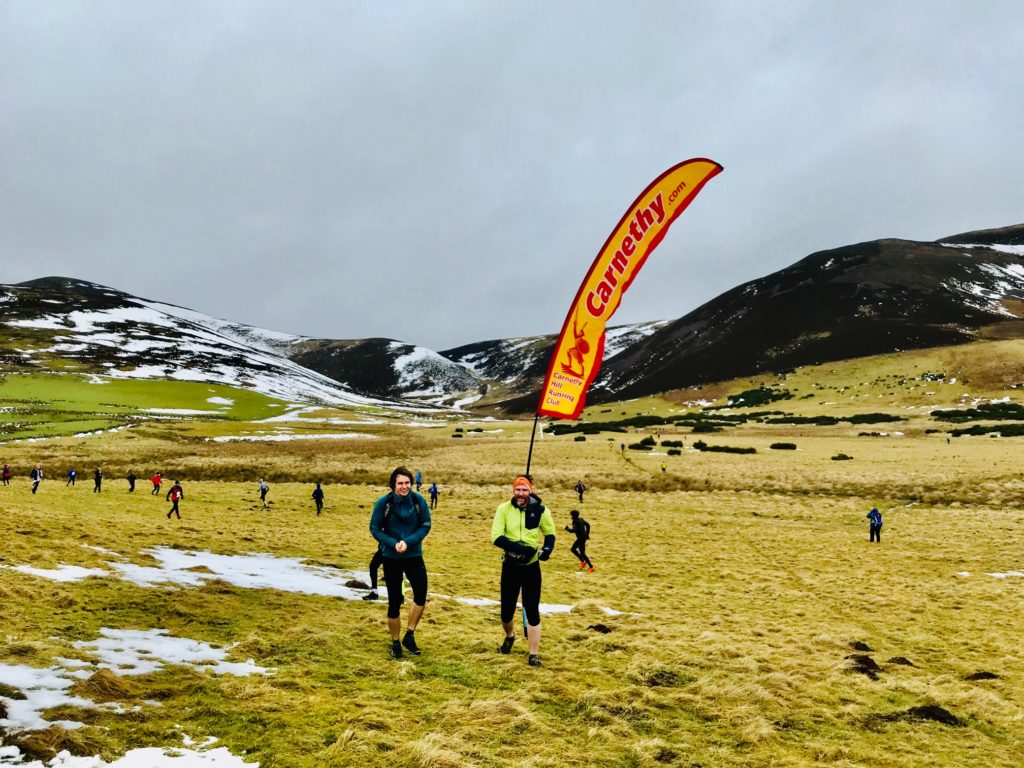
I ran as best I could, though the ground was not ground but swamp, and there was a beck crossing. So even this first half mile was hard going, as your legs are working twice as hard to accommodate the water. I felt neither good nor bad, I just kept going. FRB’s Dad had decided not to run as he was injured, but he was going to try to endure the weather and take photographs, and there he was standing on a bank before we turned to start climbing. I would get used to this sight, of a line of runners climbing in front of me, because Carnethy 5 has a purity to its planning: you go up and then you come down, five times.
In Carnethy’s description: “The race is over rough open hillside, through thick heather and boggy/rocky sections of ground, with minimal paths. The race involves 2,500′ of very steep ascent and descent, some of which you will struggle to run. It’s fair to say this race will feel a lot harder than a flat road race, but it is not beyond anyone with a reasonable level of fitness. As a very rough guide, the race organiser completes this race in somewhere between his road 10k and half marathon times.”
I climbed to Scald Law, I loved the descent, I climbed again to South Black Hill, I loved the descent, East Kip, I loved the descent, and then there was West Kip.
I can’t remember which hill I was climbing, but at one point I nearly fell backwards. A kind arm stopped me and righted me, and that was the nature of this race: there was kindness and people looking out for each other. The solidarity of fighting extreme elements. FRB had a similar experience except someone grabbed his buttocks to keep him upright. My assistance was more decorous, and I was grateful for it.
West Kip though was something else. This was the fourth hill, and by now I had begun to tire of the wind, but the wind knew this and decided to re-stoke its engines. I had my hood up as it was also hailing – of course – so I kept bumping into people as I could neither hear nor see them coming. We all trudged up as best we could. Towards the top, I was on my hands and knees and standing upright seemed actually dangerous. Here is a photograph that Peter MacDonald, one of the marshals on the top of West Kip, took, though how he managed to stay standing and use a camera is an enigma.
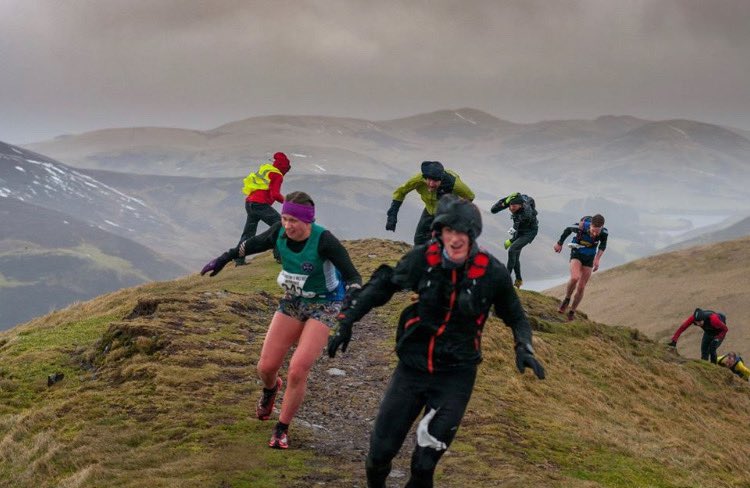
I had my phone with me, and I turned round a couple of times to look, and there were runners behind me, a trail of colour over the brown bracken and white snow of the hills, and it was pretty but not enough for me to consider taking off my gloves, getting out my phone, unwrapping it from its weather-proof sandwich bag, taking a picture and doing it all in the reverse. Too much effort. No photos.
I was so thankful to the marshals on top of these hills. The wind was so strong, it was an assault. I usually object to people using the word “brutal” about races, as most are not, not really. But this section, this struggle to stay upright while your pack is being blown off you and while you could fall off the hill: this section was brutal. I have run Tour of Pendle in a blizzard, and it was hard. I have run in hail so biting it gave me pockmarks. But I don’t think I’ve ever had to fight the weather as much as on this race. It got to the point on West Kip where it was so extreme that I had to laugh at it. What else can you do? You can’t reverse. You have to get off the hill. You may as well glory in the extremity of it and keep running.
We turned on the summit to descend and suddenly the wind was even more dangerous, because the descent was tricky and the wind was now behind: it didn’t get us on the top so now it wanted to push us down a steep slope. I persevered, and my legs began to enjoy the descent, steep at first then levelling out. Not flat though: I knew this because I was overtaking people and I only ever do that on descents. The final part before we descended towards Loganlea reservoir was a grassy muddy bank. I slipped, and then suddenly slid at great speed, so fast I didn’t know how to stop, until a bush helped me out. It was great fun and I was laughing out loud, and quietly thankful that no rocks had punctured my backside on the way. The power of that slide! A fellow runner congratulated me on it and I agreed that yes, it was some of my finest work.
Onwards to the reservoir, then to the cut-off, which I had forgotten about. Nor had I checked my watch. The cut-off was 1 hour 15, and I think I got there in about an hour but as I didn’t even realise it was a cut-off, that didn’t matter. About 20 runners didn’t make it. (I mean, they weren’t quick enough, not that they expired.)
Up again now, for the final climb to Carnethy Hill. I was alongside a man in shorts who said he rather regretted not wearing long trousers, as his legs were blue. There, again, was FRB Dad, taking pictures and joking with folk he knew, of which there were plenty.
I got myself up the hill and then there was the joy of the final descent. Tim had warned me before about this part, that there was gorse that bit and rocks that made you stumble, and that the two together were rather testing. But much of the gorse and heather had been burned and tamed. There were a few sections of scree-sliding, and then a hell-for-leather how-do-I-stop careering, which was fun. For a while I couldn’t figure out why I could hear the powerful jet engines of an airliner, until I realised it was the wind in my hood.
Then the long slog back over the swamp and through the beck to the finish. A photographer at the beck got some excellent pictures, though not of me (I stayed upright).
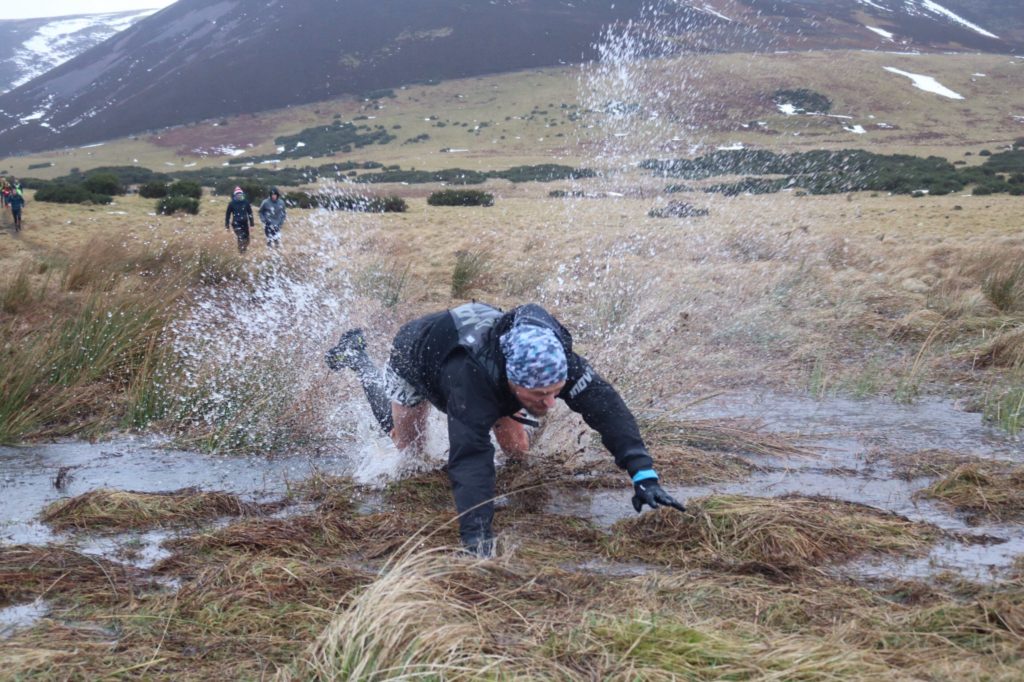
And there were the feather flags of the finish, and FRB standing waiting for me. I had a cup of hot liquid which may have been tea or coffee and it didn’t matter at all which, and a biscuit. Then FRB said, shall we run back instead of waiting for buses? And I must have been on such a high from the final descent that I agreed without question. A marshal gave us directions for the three miles back to the school, which ended up being mostly farm tracks and woodland, so it was pleasant.
Just as we approached Beeslack High School, the rain began and then it intensified, and we arrived back to a downpour. There were changing rooms and showers but with 500 entrants, including a healthy proportion of women, there was no room, so I had a wet-wipe shower in the middle of the sports hall, with the help of a judiciously placed towel. Then I headed to the kitchen for food, which was a lentil dal or a spicier vegetable curry, and it was delicious. In fact, the £17 was good value, as we had also been given a bottle of Carnethy 5 beer, a 50th anniversary mug and a beer mat.
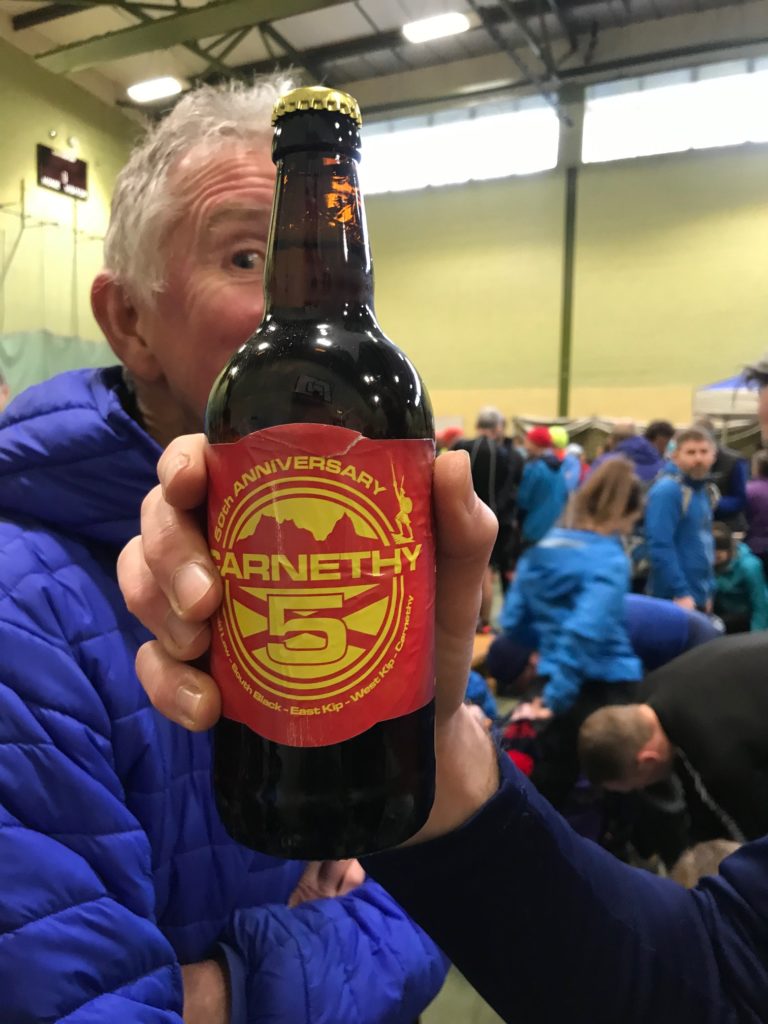
I realised afterwards that I’d been sitting next to a woman who had run the whole race although she was 80 or thereabouts. I wish I’d known because I would have genuflected at her feet. In the main hall, Jasmin Paris and her husband were hanging out, and I got starstruck, by Jasmin as well as by her daughter Rowan, who became as famous as her mum after the Spine Race. I left them be though. Nobody wants to be bothered by genuflecting strangers, do they?
We didn’t stay for prizegiving, although I did want to see the female and male winner each get a broadsword. Me, I got my beer and beer mat and mug, and I was happy to have those as well as significant satisfaction at having run a race in actually brutal conditions, and doing alright. My profound gratitude to everyone who stood out in those winds to marshal: thank you.
Do I think they were right to run the race? Yes. Though it took courage to do it.
I came 404 out of 503 runners, and I’m pleased with that. I think I’ll be back.

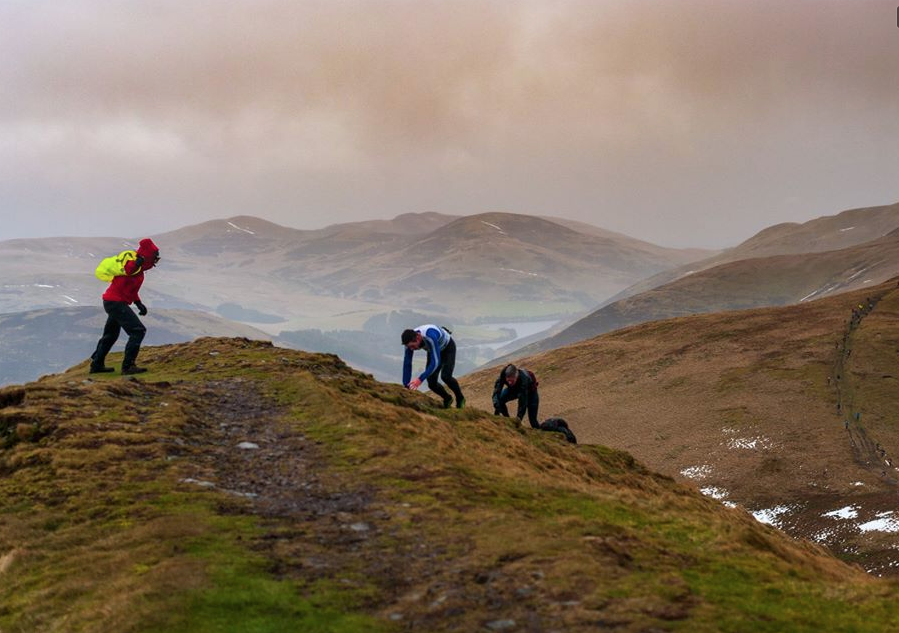
Loved reading this, it’s had me hooked since 2012 when it was a British champs race. I only traveled up from Cumbria to take photos, I new then I would be back. I have only missed running two races since, 2016 I never got a place but went up with my camera anyway. And this year I had a Heart Attack on the 16th January. It stopped me running but not going up to take photos, was just a pity I was not allowed to venture up the hill and stayed on the start field. Absolutely my favourite race, running or taking photos. See you next year, hopefully I will be running again.
Thanks for your excellent pics Paul and hope to see you running again soon with a fully healed heart.
Awesome write up. What a race eh?
Thanks Ali: it’s a cracker.